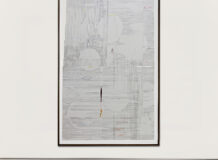By Daniel Molina
Art is lightning in the middle of the darkest night. For a moment it allows us to see something that barely remains in memory. What did we see? A ghost, echo of our delirium? The key we have been looking for since we were little? The lightning lasts an instant, but what we glimpse stuns us with the same force as the deafening noise of thunder that follows the burst of light. Guided by such a quiet light (pure lightning without thunder!), Jorge Miño’s art transforms objects into silent hallucinations.
It records them so we can watch them disappear. It appeals to an inverse baroque style: the final image comes from direct photography, but it is only possible because it has been subjected to a proliferating calligraphy that transforms it into a pure geometric abstraction. What we see is real, but nothing survives of reality other than some blurred memory. We see what is impossible to see. Because from the image captured by the camera there is nothing left but the memory (hallucinated, sometimes precise, transmuted into something else, inscribed in a labyrinth of mirrors, torn by a golden tone) Miño is increasingly betting on new supports. From the photographs he produces objects in high and low relief by superimposing several openwork sheets of tracing paper. It transforms the transparency of this support into the opacity of an unstable cluster. There is some play and threat (in that play). Liquid stone, it dilutes because it consolidates: the staircase has become, for Miño, an icon of the perpetual unstable. The oxymoron defines it. The staircase is a bridge. It goes from one side to the other, but there is no other side. It connects spaces, but there are no spaces. It is a self-centered universe that allows us to dream of other universes. In Miño’s previous samples the staircase was a metaphor: it indicated something that was not in the image; He spoke of an outside of the work. In this exhibition, the staircase is metalanguage: the sign that speaks about itself. From imagination to reflection, from reflection to abstraction, Miño’s photography is like music without sound: what John Cage was looking for. Centuries ago it was called poetry.
